|

|
|
| |
|
China Oil Painting Direct
|
|
100% hand painted, 100%
cotton canvas,
100% money back if not satisfaction.
|
|
|
|
ART WORKS
INDEX
A B C D E F G H I J K L M N O P Q R S T U V W X Y Z
|
|
ARTISTS
INDEX
A B C D E F G H I J K L M N O P Q R S T U V W X Y Z
|
|
|
|
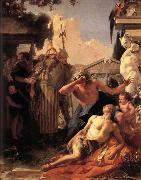 |
Giambattista Tiepolo 
|
|
1696-1770
Italian painter, master of Venetian school. Tiepolo was famous in his own lifetime as a superb painter in fresco and a brilliant draftsman. A highly inventive artist, he could create spectacular effects in difficult sites, from the narrow gallery at the patriarchal palace at Udine in the mid-1720s to the vast staircase ceiling in the Residenz at Werzburg in the early 1750s. Contemporaries recognized his spirited, dynamic approach to subject matter and his frankly sensuous manner of painting. Tiepolo is comparable in his restless energy and imaginative power to Peter Paul Rubens, and essentially he worked with a similar baroque language of myth, allegory, and history, which he infused with a sense of freshness and modernity. His approach to religious art is characterized by candor and naturalism, while he was responsive to the different concerns of patrons and viewers at a time when the church was faced with new kinds of devotion and criticism. With the advent of neoclassicism, Tiepolo's art fell from favor: In an age that prized archaeological correctness, rationality, and ideals of improvement, his witty, Veronese-inspired conception of historical or classical subjects seemed frivolous, while his visually seductive qualities were seen as inimical to the serious intellectual aims of the new art. Nevertheless, his drawings and oil sketches continued to appeal to collectors, including Antonio Canova. The son of a Venetian shipping merchant, Tiepolo was apprenticed in 1710 to Gregorio Lazzarini (1655C1730), an artist of international reputation patronized by prominent Venetian families. Before becoming an independent master, he worked in the household of Doge Giovanni Corner; members of the Corner family were to be his most steadfast and liberal patrons. Lazzarini encouraged his pupils to study Venetian sixteenth-century art, and Tiepolo made drawings of some famous works for publication in Domenico Lovisa's Gran Teatro di Venezia of 1717. His early involvement with the thriving Venetian engraving and publishing world was renewed in 1724 when he made drawings of antique sculpture as illustrations for Scipione Maffei's Verona Illustrata, an experience that gave Tiepolo an imaginative empathy with fragmentary antique remains, which recur in his drawings, etchings, and paintings. As well as studying the art of the past, Tiepolo looked to the tenebrism of Federico Bencovich (1677C1753) and the realism and monumentality of Giovanni Battista Piazzetta (1682C1754). In 1719 Tiepolo married Cecilia Guardi, with whom he was to have nine children. By then, the artist was working for a network of mercantile and noble patrons on religious and secular subjects.
|
|
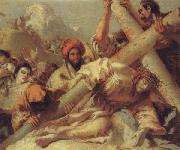 |
Giandomenico Tiepolo 
|
|
Italian Rococo Era Painter , Venice 1727 - 1804
was a painter and printmaker in etching, son of artist Giovanni Battista Tiepolo and elder brother of Lorenzo Baldissera Tiepolo. Domenico was born in Venice, studied under his father, and by the age of 13 was the chief assistant to him. He was one of the many assistants, including Lorenzo, that transferred the designs of his father (executed in the 'oil sketch' invented by the same). By the age of 20, he was producing his own work for commissioners. He assisted his father in Werzburg 1751-3, decorating the famous stairwell fresco, in Vicenza at the Villa Valmarana in 1757,
|
|
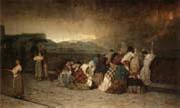 |
Gioacchino Toma 
|
|
Italian , Galatina 1836 - Napoli 1891
Italian painter. He was orphaned at the age of six and spent an unhappy childhood and adolescence in convents and poorhouses; these experiences would later provide subjects for his paintings. He was first taught drawing at the art school in the hospice for the poor in the Adriatic town of Giovinazzo, but in 1855 he moved to Naples, where he worked for an ornamental painter named Alessandro Fergola. In 1857 he was mistakenly arrested for conspiracy and exiled to Piedimonte d'Alife, 60 km from Naples, where he was initiated into the secret society of the Carbonari by some local liberal aristocrats who also became his first patrons. His paintings for them were mainly still-lifes, largely in the traditional Neapolitan style. On his return to Naples in 1858 he became a student at the Accademia di Belle Arti, attending the classes of Domenico Morelli, who influenced such early works as Erminia (1859; Naples, Pal. Reale). Toma fought for two years with Garibaldi in the campaign for the unification of Italy, then returned to painting,
|
|
 |
Giovanni Battista Tiepolo 
|
|
Italian Rococo Era Painter, 1696-1770
Giovanni Battista Tiepolo was born in Venice on March 5, 1696. His father, who was part owner of a ship, died when Tiepolo was scarcely a year old, but the family was left in comfortable circumstances. As a youth, he was apprenticed to Gregorio Lazzarini, a mediocre but fashionable painter known for his elaborately theatrical, rather grandiose compositions.
Tiepolo soon evolved a more spirited style of his own. By the time he was 20, he had exhibited his work independently, and won plaudits, at an exhibition held at the church of S. Rocco. The next year he became a member of the Fraglia, or painters guild. In 1719 he married Cecilia Guardi, whose brother Francesco was to become famous as a painter of the Venetian scene. They had nine children, among them Giovanni Domenico and Lorenzo Baldassare, who were also painters.
In the 1720s Tiepolo carried out many large-scale commissions on the northern Italian mainland. Of these the most important is the cycle of Old Testament scenes done for the patriarch of Aquileia, Daniele Dolfin, in the new Archbishop Palace at Udine. Here Tiepolo abandoned the dark hues that had characterized his early style and turned instead to the bright, sparkling colors that were to make him famous.
|
|
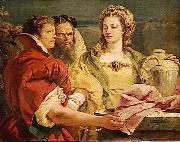 |
Giovanni Domenico Tiepolo 
|
|
(August 30, 1727 - March 3, 1804) was a Venetian painter and printmaker in etching. He was the son of artist Giovanni Battista Tiepolo and elder brother of Lorenzo Baldissera Tiepolo..
Domenico was born in Venice, studied under his father, and by the age of 13 was the chief assistant to him. He was one of the many assistants, including Lorenzo, that transferred the designs of his father (executed in the 'oil sketch' invented by the same). By the age of 20, he was producing his own work for commissioners.
He assisted his father in Werzburg 1751-3, decorating the famous stairwell fresco, in Vicenza at the Villa Valmarana in 1757, and in Madrid at the palace of Charles III from 1762-70.
|
|
 |
Giovanni Toscani 
|
|
Italian Painter, ca.1370-1430
|
|
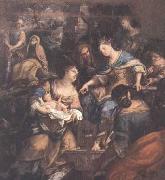 |
Giovanni Tuccari 
|
|
Giovanni Tuccari (1667-1743) was an Italian painter during the Baroque period, active in Sicily.
Tuccari was born in Messina. He was the son and pupil of Antonio Tuccari, an obscure painter. He excelled as a battle painter. He died of the plague. He was responsible for the frescos in the Church of San Benedetto in Catania. Other examples of his work include four octagonal paintings in the sanctuary of the Church of S. Antonio, at Castiglione di Sicilia, and La Pinacoteca Zelantea gallery in Acireale.
|
|
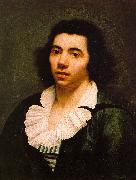 |
Girodet-Trioson, Anne-Louis 
|
|
French Neoclassical Painter, 1767-1824
French painter. Originally named Girodet de Roussy or Roucy, he was a student of J.-L. David, and his classical training was sometimes at variance with his often eccentrically romantic expression. He won the Prix de Rome and while in Italy painted the Sleep of Endymion (1791; Louvre), a sensual and erotically ambiguous work that brought him widespread recognition. His Deluge (Louvre) demonstrates Girodet's interest in unusual color and lighting problems. Much of his work, including a series for Malmaison (Napoleon's residence), glorifies Napoleon.
|
|
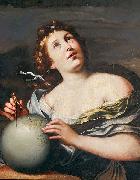 |
Girolamo Troppa 
|
|
Girolamo Troppa (1637-1710) was an Italian painter of the Baroque. He was active in Rome. He was a follower of Carlo Maratti. He painted for the church of San Giacomo delle Penitenti, in competition with the son of Giovan Francesco Romanelli. He died in 1710.
|
|
 |
Giuseppe Maria Terreni 
|
|
Italian , (1739-1811)
|
|
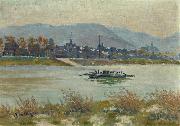 |
Gottfried Trimborn 
|
|
painted Rheinfahre in 1920
|
|
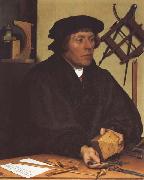 |
Hans holbein the younger 
|
|
b. 1497, Augsburg, d. 1543, London
was a German artist and printmaker who worked in a Northern Renaissance style. He is best known as one of the greatest portraitists of the 16th century.[2] He also produced religious art, satire and Reformation propaganda, and made a significant contribution to the history of book design. He is called "the Younger" to distinguish him from his father, Hans Holbein the Elder, an accomplished painter of the Late Gothic school. Born in Augsburg, Holbein worked mainly in Basel as a young artist. At first he painted murals and religious works and designed for stained glass windows and printed books. He also painted the occasional portrait, making his international mark with portraits of the humanist Desiderius Erasmus of Rotterdam. When the Reformation reached Basel, Holbein worked for reformist clients while continuing to serve traditional religious patrons. His Late Gothic style was enriched by artistic trends in Italy, France, and the Netherlands, as well as by Renaissance Humanism. The result was a combined aesthetic uniquely his own. Holbein travelled to England in 1526 in search of work, with a recommendation from Erasmus. He was welcomed into the humanist circle of Thomas More, where he quickly built a high reputation. After returning to Basel for four years, he resumed his career in England in 1532. This time he worked for the twin founts of patronage, Anne Boleyn and Thomas Cromwell. By 1535, he was King's Painter to King Henry VIII. In this role, he produced not only portraits and festive decorations but designs for jewellery, plate, and other precious objects. His portraits of the royal family and nobles are a vivid record of a brilliant court in the momentous years when Henry was asserting his supremacy over the English church. Holbein's art was prized from early in his career. The French poet and reformer Nicholas Bourbon dubbed him "the Apelles of our time".[3] Holbein has also been described as a great "one-off" of art history, since he founded no school.[4] After his death, some of his work was lost, but much was collected, and by the 19th century, Holbein was recognised among the great portrait masters. Recent exhibitions have also highlighted his versatility.
|
|
 |
Hans Thoma 
|
|
German Symbolist Painter, 1839-1924
German painter, printmaker and museum director. He was the son of a miller, craftsman and smallholder and studied briefly as a lithographer in Basle in 1854 before being apprenticed to a watchcase painter in Furtwangen. Returning home the same year, he started to draw and paint in his spare time. In 1859 he enrolled at the Kunstschule in Karlsruhe, where he studied until 1866 with Ludwig Des Coudres (1820-78) and the landscape painter Johann Wilhelm Schirmer, by whom he was especially influenced. He spent his summer vacations drawing and painting in Bernau, and his landscapes, portraits and genre pictures from this time record his transition from amateur painter to accomplished artist. His pictures of his mother and his sister Agathe
|
|
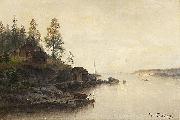 |
Harald Torsslow 
|
|
(1838 -1909 ) - Painter
|
|
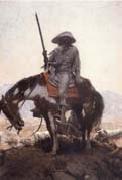 |
Harvey T. Dunn 
|
|
American, 1884-1952
|
|
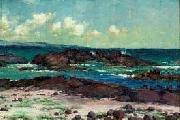 |
Helen Thomas Dranga 
|
|
Helen Thomas Dranga (1866-1940), who is also known as Carrie Helen Dranga, was a painter who was born Carrie Helen Tufts in Oxford, England. She lived in Oakland, California from 1894 until 1900, when she moved to Hilo, Hawaii. Her paintings regularly appeared on the cover of Paradise of the Pacific magazine in the 1920s and 1930s. She lived in Hilo until shortly before her death in 1940.
The Honolulu Academy of Arts and the Lyman House Memorial Museum (Hilo, Hawaii) are among the public collections holding works by Helen Thomas Dranga
|
|
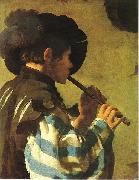 |
Hendrick ter Brugghen 
|
|
(1588 - Nov 1, 1629) was a Dutch painter, and a leading member of the Dutch followers of Caravaggio ?? the so-called Dutch Caravaggisti.
Little is known of the early life of ter Brugghen; he could have been born in The Hague, but his family seems to have moved to the strongly Catholic Utrecht in the early 1590s. Here he started painting at the age of thirteen, studying with Abraham Bloemaert. From Bloemaert, a Mannerist history painter, he learned the basics of the art. Around 1604, however, ter Brugghen travelled to Italy to expand his skills, a rather unusual move for Dutch painters at the time. He was in Rome in 1604, and could therefore have been in direct contact with Caravaggio.
|
|
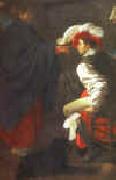 |
Hendrick Terbrugghen 
|
|
1588-1629
Dutch Hendrick Terbrugghen Galleries
Dutch painter and draughtsman. He was, with Gerrit van Honthorst and Dirck van Baburen, one of the leading painters in the group of artists active in Utrecht in the 1620s who came to be known as the UTRECHT CARAVAGGISTI, since they adapted Caravaggio subject-matter and style to suit the Dutch taste for religious and secular paintings. Ter Brugghen was an important innovator for later Dutch 17th-century genre painting; his recognition as an unorthodox, but significant influence on the work of Johannes Vermeer and others is a relatively recent, 20th-century phenomenon.
|
|
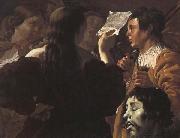 |
Hendrick the Brugghen 
|
|
1588-1629
Dutch painter and draughtsman. He was, with Gerrit van Honthorst and Dirck van Baburen, one of the leading painters in the group of artists active in Utrecht in the 1620s who came to be known as the UTRECHT CARAVAGGISTI, since they adapted Caravaggio's subject-matter and style to suit the Dutch taste for religious and secular paintings. Ter Brugghen was an important innovator for later Dutch 17th-century genre painting; his recognition as an unorthodox,
|
|
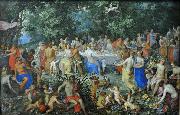 |
Hendrick van Balen the Elder 
|
|
painted The Wedding of Thetis and Perseus with Apollo and the Concert of the Muses, or The Feast of the Gods in ca. 1618
|
|
 |
Henri Toulouse-Lautrec 
|
|
French Post-Impressionist Painter and Printmaker, 1864-1901
Henri de Toulouse-Lautrec, a direct descendant of the counts of Toulouse, was born on Nov. 24, 1864, at Albi. His eccentric father lived in provincial luxury, hunting with falcons and collecting exotic weapons. Henri began to draw at an early age. He suffered a fall in 1878 and broke one femur; in 1879 he fell again and broke the other one. His legs did not heal properly; his torso developed normally, but his legs were permanently deformed.
Encouraged by his first teachers, the animal painters Rene Princeteau and John Lewis Brown, Toulouse-Lautrec decided in 1882 to devote himself to painting, and that year he left for Paris. Enrolling at the Ecole des Beaux-Arts, he entered the studio of Fernand Cormon. In 1884 Toulouse-Lautrec settled in Montmartre, where he stayed from then on, except for short visits to Spain, where he admired the works of El Greco and Diego Velazquez; Belgium; and England, where he visited Oscar Wilde and James McNeill Whistler. At one point Toulouse-Lautrec lived near Edgar Degas, whom he valued above all other contemporary artists and by whom he was influenced. From 1887 his studio was on the Rue Caulaincourt next to the Goupil printshop, where he could see examples of the Japanese prints of which he was so fond.
Toulouse-Lautrec habitually stayed out most of the night, frequenting the many entertainment spots about Montmartre, especially the Moulin Rouge cabaret, and he drank a great deal. His loose living caught up with him: he suffered a breakdown in 1899, and his mother had him committed to an asylum at Neuilly. He recovered and set to work again. He died on Sept. 9, 1901, at the family estate at Malrome.
|
|
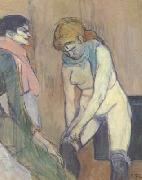 |
Henri de toulouse-lautrec 
|
|
1864-1901
French painter and printmaker. He is best known for his portrayals of late 19th-century Parisian life, particularly working-class, cabaret, circus, nightclub and brothel scenes. He was admired then as he is today for his unsentimental evocations of personalities and social mores. While he belonged to no theoretical school, he is sometimes classified as Post-Impressionist. His greatest contemporary impact was his series of 30 posters (1891-1901),
|
|
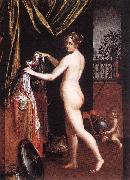 |
Henri Testelin 
|
|
(Paris, 1616 - The Hague, 1695) was a French art painter.
Henri Testelin made portraits of Louis XIV, important persons and events at the French court . Several of his paintings can be seen in the palace of Versailles. The portraits, like the one of the young Louis XIV, show the influence of Jean Nocret and Le Brun.
He was secretary of Royal Academy of Painting and Sculpture from 1650 and professor from 1656. In 1680 he published a book on art theory and the academy. Testelin was dismissed from the Academy in 1681, because he was proptestant. He left France and went to Holland.
|
|
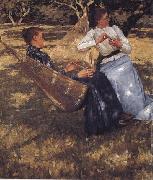 |
Henry Herbert La Thangue 
|
|
British painter , 1850-1920
|
|
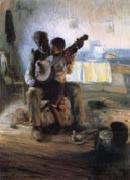 |
Henry Ossawa Tanner 
|
|
African-American Realist Painter, 1859-1937
American painter. He was one of the foremost African American artists, achieving an international reputation in the early years of the 20th century for his religious paintings. The son of an African Methodist Episcopal bishop, he studied art with Thomas Eakins from 1880 to 1882 at the Pennsylvania Academy of the Fine Arts in Philadelphia. He then worked in Philadelphia and Atlanta, GA, where he ran a photography studio and taught at Clark College.
|
|
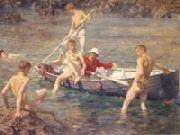 |
Henry Scott Tuke 
|
|
British Painter and photographer , 1858-1929
English painter. He entered the Slade School of Art, London, in 1875, under Alphonse Legros and Sir Edward Poynter. In 1877 he won a Slade scholarship and in 1880 travelled to Italy, where he made his first nude life drawings, an important revelation to him of light, colour and the human form. From 1881 to 1883 he was in Paris and met Jules Bastien-Lepage, who encouraged his studies en plein air.
|
|
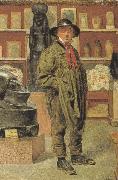 |
Henry stacy marks,R.A. 
|
|
1829-1898
English painter. He studied with J. M. Leigh (1808-60) from 1847 and in January 1851 enrolled at the Royal Academy Schools. In 1852 Marks and P. H. Calderon spent five months studying in Paris under Fran?ois-Edouard Picot and at the Ecole des Beaux-Arts. The next year he made his d?but at the Royal Academy Summer Exhibition, where he exhibited annually until 1897. He was elected ARA in 1871 and RA in 1878.
|
|
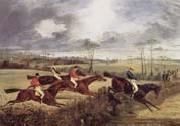 |
Henry Thomas Alken 
|
|
1785-1851, Painter and engraver, son of Samuel Alken. He worked in London and the provinces and was prolific in a variety of media while unadventurous in his range of subject-matter. Early instruction by the miniature painter J. T. Beaumont (1774-1851) helped to give a certain graphic precision
|
|
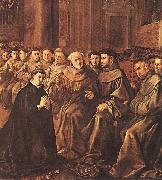 |
HERRERA, Francisco de, the Elder 
|
|
Spanish painter (b. ca. 1590, Sevilla, d.
1656, Madrid).
Spanish painter. His early works are in the Mannerist style. Under the influence of Francisco Zurbaron, he developed the naturalistic style seen in his four scenes from the life of St. Bonaventure (1627). About 1650 he moved to Madrid. His last documented work, a painting of St. Joseph (1648) influenced by Anthony Van Dyck, features elongated forms and elaborate draperies. He achieved considerable fame in Sevilla, where Diego Velezquez was briefly his pupil.
|
|
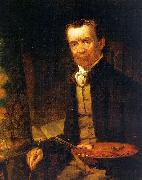 |
Hicks, Thomas 
|
|
American Painter, 1823-1890
Cousin of Edward Hicks. After being apprenticed (c. 1835-9) in the sign-painting shop of his cousin, he studied at the Pennsylvania Academy of the Fine Arts in Philadelphia (1839-40) and at the National Academy of Design in New York (1840-44). He then sketched and painted in England, Italy and France before becoming a student of Thomas Couture in Paris (1848-9). On his return to the USA in 1849, he established a studio in New York and quickly became a popular portrait painter, although his portrayals only rarely have enough psychological depth to make them of more than documentary interest. Hamilton Fish (1852; New York, City Hall) is among his stronger works. Hicks also painted genre subjects, such as Musicale: Barber Shop, Trenton Falls (1866; Raleigh, NC Mus. A.), and landscapes, the latter chiefly near Thornwood, his summer residence at Trenton Falls, NY.
|
|
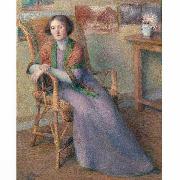 |
Hippolyte Petitjean 
|
|
Hippolyte Petitjean (1854 - 1929)
|
|
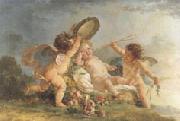 |
Hughes Taraval 
|
|
1729-1785
|
|
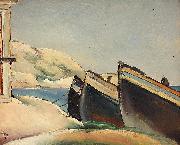 |
Ion Theodorescu Sion 
|
|
Ion Theodorescu-Sion (1882-1939).
Alternative names Onu Soare Teodor.
Romanian painter.
|
|
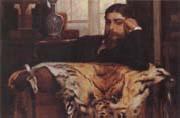 |
J.J.Tissot 
|
|
French
1836-1902
|
|
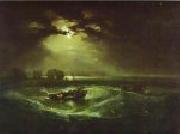 |
J.M.W. Turner 
|
|
English Romantic Painter, 1775-1851 landscape master
landscape master .British painter and printmaker. He dominated British landscape painting throughout the first half of the 19th century. He established a reputation in the Royal Academy, London, first as a topographical watercolourist and then within a few years as a painter of Sublime and historical landscapes.
|
|
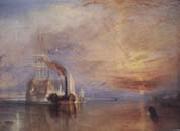 |
J.M.W.Turner 
|
|
English Romantic Painter, 1775-1851, British land- and seascape artist. Born in London the son of a barber, Turner was precociously talented. He entered the RA Schools in 1789, had a drawing exhibited at the academy in 1790, and was elected a full academician in 1802. He became professor of perspective in 1807. A prolific artist of amazing range of subject and style, he began work in water-colours, quickly founding both a reputation and a fortune, which made him independent of changing public taste. His work was not appreciated by everyone, but his supporters included Thomas Lawrence, John Ruskin, and the earl of Egremont. He died in eccentric obscurity under a false name.
|
|
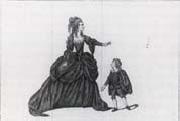 |
J.Thornthwaite 
|
|
British.fl.late eighteenth century
|
|
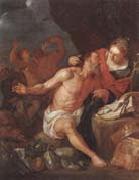 |
Jacob Toorenvliet 
|
|
Dutch Baroque Era Painter ,
Leiden circa 1635-1719
|
|
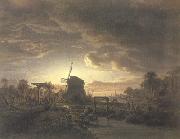 |
Jacobus Theodorus Abels 
|
|
1803-1866
|
|
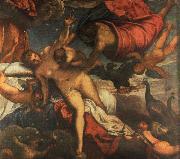 |
Jacopo Robusti Tintoretto 
|
|
1518-1594
Italian Tintoretto Galleries
The real name of Tintoretto was Jacopo Robusti, but he is better known by his nickname, meaning the "little dyer, " his father having been a silk dyer. The artist was born in Venice and lived there all his life. Even though his painting is distinguished by great daring, he seems to have led a rather retired life, concerned only with his work and the well-being of his family. His daughter Marietta and his sons Domenico and Marco also became painters, and Domenico eventually took over the direction of Tintoretto's large workshop, turning out reliable but un-inspired pictures in the manner of his father. Some of them are, on occasion, mistaken for works of the elder Tintoretto.
Tintoretto appears to have studied with Bonifazio Veronese or Paris Bordone, but his true master, as of all the great Venetian painters in his succession, was Titian. Tintoretto's work by no means merely reflects the manner of Titian. Instead he builds on Titian's art and brings into play an imagination so fiery and quick that he creates an effect of restlessness which is quite opposed to the staid and majestic certainty of Titian's statements. If Tintoretto's pictures at first sight often astonish by their melodrama, they almost inevitably reveal, at closer observation, a focal point celebrating the wonders of silence and peace. The sensation of this ultimate gentleness, after the first riotous impact, is particularly touching and in essence not different from what we find (although brought about by very different means) in the pictures of Titian and Paolo Veronese.
Tintoretto was primarily a figure painter and delighted in showing his figures in daring foreshortening and expansive poses. His master in this aspect of his art was Michelangelo. Tintoretto is supposed to have inscribed on the wall of his studio the motto: "The drawing of Michelangelo and the color of Titian." Unlike Michelangelo, however, Tintoretto worked and drew very quickly, using only lights and shadows in the modeling of his forms, so that his figures look as if they had gained their plasticity by a kind of magic. In the rendering of large compositions he is reported to have used as models small figures which he made of wax and placed or hung in boxes so cleverly illuminated that the conditions of light and shade in the picture he was painting would be the same as those in the room in which it was to be hung.
|
|
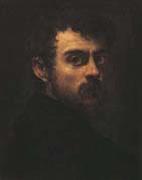 |
Jacopo Tintoretto 
|
|
1518-1594
Italian painter. His father was a silk dyer (tintore); hence the nickname Tintoretto ("Little Dyer"). His early influences include Michelangelo and Titian. In Christ and the Adulteress (c. 1545) figures are set in vast spaces in fanciful perspectives, in distinctly Mannerist style. In 1548 he became the centre of attention of artists and literary men in Venice with his St. Mark Freeing the Slave, so rich in structural elements of post-Michelangelo Roman art that it is surprising to learn that he had never visited Rome. By 1555 he was a famous and sought-after painter, with a style marked by quickness of execution, great vivacity of colour, a predilection for variegated perspective, and a dynamic conception of space. In his most important undertaking, the decoration of Venice's Scuola Grande di San Rocco (1564 ?C 88), he exhibited his passionate style and profound religious faith. His technique and vision were wholly personal and constantly evolving.
|
|
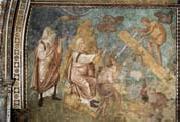 |
Jacopo Torriti 
|
|
Italian painter, Roman school active c. 1270-1300, Italian painter and mosaicist. Two mosaics in Rome are signed by him: one, on the apse of S Giovanni in Laterano, that once bore the date 1291 (or, according to some sources, 1290 or 1292); and another on the apse and triumphal arch of S Maria Maggiore, now replaced by a 19th-century restoration but at one time dated 1295 or 1296. Torriti is also known to have executed a mosaic for Arnolfo di Cambio's tomb of Pope Boniface VIII (1296; destr.; see ARNOLFO DI CAMBIO) in Old St Peter's, Rome. Torriti was active during the same period as Cimabue and Giotto, Pietro Cavallini and Arnolfo di Cambio, but his fame has been obscured by theirs, no doubt because of his closer links with Byzantine art. He was nevertheless one of the most important artists working in Rome during the papacy of Nicholas IV (1288-92) and was entrusted with some of the most prestigious commissions of the day.
|
|
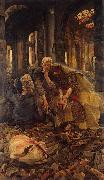 |
James Jacques Joseph Tissot 
|
|
(15 October 1836 -- 8 August 1902) was a French painter.
Tissot was born at Nantes. He studied at the École des Beaux-Arts in Paris under Ingres, Flandrin and Lamothe, and exhibited in the Paris Salon for the first time at the age of twenty-three. In 1861 he showed The Meeting of Faust and Marguerite, which was purchased by the state for the Luxembourg Gallery. His first characteristic period made him a painter of the charms of women. Demi-mondaine would be more accurate as a description of the series of studies which he called La Femme a Paris.
|
|
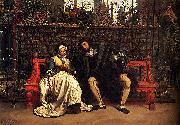 |
James Joseph Jacques Tissot 
|
|
James Jacques Joseph Tissot (15 October 1836 - 8 August 1902) was a French painter, who spent much of his career in Britain.
Tissot was born in Nantes, France. In about 1856, he began study at the École des Beaux-Arts in Paris under Hippolyte Flandrin and Lamothe, and became friendly with Edgar Degas and James Abbott McNeill Whistler. Tissot exhibited in the Paris Salon for the first time in 1859, two portraits of women and three scenes in medieval dress from Faust. The latter show the influence of the Belgian painter Henri Leys (Jan August Hendrik Leys), whom he had met in Antwerp in 1859. In the mid-1860s, however, Tissot began to concentrate on depicting women, often although not always shown in modern dress. Like contemporaries such as Alfred Stevens and Claude Monet, Tissot also explored japonisme, including Japanese objects and costumes in his pictures. A portrait of Tissot by Degas from these years (Metropolitan Museum of Art, New York) shows him with a Japanese screen hanging on the wall.
|
|
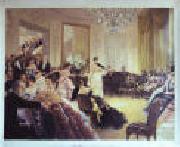 |
James Tissot 
|
|
French Painter, 1836-1902
French painter, printmaker and enamellist. He grew up in a port, an experience reflected in his later paintings set on board ship. He moved to Paris c. 1856 and became a pupil of Louis Lamothe and Hippolyte Flandrin. He made his Salon d?but in 1859 and continued to exhibit there successfully until he went to London in 1871. His early paintings exemplify Romantic obsessions with the Middle Ages, while works such as the Meeting of Faust and Marguerite (exh. Salon 1861; Paris. Mus. d'Orsay) and Marguerite at the Ramparts (1861; untraced, see Wentworth, 1984, pl. 8) show the influence of the Belgian painter Baron Henri Leys. In the mid-1860s Tissot abandoned these tendencies in favour of contemporary subjects, sometimes with a humorous intent, as in Two Sisters (exh. Salon 1864; Paris, Louvre) and Beating the Retreat in the Tuileries Gardens (exh. Salon 1868; priv. col., see Wentworth, 1984, pl. 45). The painting Young Ladies Looking at Japanese Objects (exh. Salon 1869; priv. col., see Wentworth, 1984, pl. 59) testifies to his interest in things Oriental, and Picnic (exh. Salon 1869; priv. col., see 1984 exh. cat., fig. 27), in which he delved into the period of the Directoire, is perhaps influenced by the Goncourt brothers. Tissot re-created the atmosphere of the 1790s by dressing his characters in historical costume.
|
|
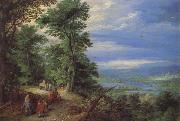 |
Jan Brueghel The Elder 
|
|
Flemish Baroque Era Painter, 1568-1625
was a Flemish painter, son of Pieter Brueghel the Elder and father of Jan Brueghel the Younger. Nicknamed "Velvet" Brueghel, "Flower" Brueghel, and "Paradise" Brueghel, of which the latter two were derived from favored subjects, while the former may refer to the velveteen sheen of his colors or to his habit of wearing velvet. He was born in Brussels. His father died in 1569, and then, following the death of his mother in 1578, Jan, along with his brother Pieter Brueghel the Younger ("Hell Brueghel") and sister Marie, went to live with their grandmother Mayken Verhulst (widow of Pieter Coecke van Aelst). She was an artist in her own right, and according to Carel van Mander, possibly the first teacher of the two sons. The family moved to Antwerp sometime after 1578. He first applied himself to painting flowers and fruits, and afterwards acquired considerable reputation by his landscapes and sea-pieces. He formed a style more independent of his father's than did his brother Pieter the Younger. His early works are often landscapes containing scenes from scripture, particularly forest landscapes betraying the influence of the master forest landscape-painter Gillis van Coninxloo. Later in his career, he moved toward the painting of pure landscapes and townscapes, and, toward the end, of still lifes. After residing long at Cologne he travelled into Italy, where his landscapes, adorned with small figures, were greatly admired. He left a large number of pictures, chiefly landscapes, which are executed with great skill. Many of his paintings are collaborations in which figures by other painters were placed in landscapes painted by Jan Brueghel.
|
|
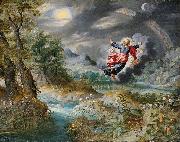 |
Jan Brueghel the Younger 
|
|
(September 13, 1601 C September 1, 1678) was a Flemish Baroque painter, and the son of Jan Brueghel the Elder.
He was trained by his father and spent his career producing works in a similar style. Along with his brother Ambrosius, he produced landscapes, allegorical scenes and other works of meticulous detail. Brueghel also copied works by his father and sold them with his father's signature. His work is distinguishable from that of his parent by being less well executed and lighter.
Jan the Younger was traveling in Italy when his father died of cholera and swiftly returned to take control of the Antwerp studio. He soon established himself and was made dean of the Guild of Saint Luke in 1630. That same year he was commissioned by the French court to paint Adam Cycle. In the following years, he also produced paintings for the Austrian court, and worked independently in Paris, before returning to Antwerp in 1657. He collaborated with a number of prominent artists including Rubens, Hendrick van Balen (1575-1632), Adriaen Stalbemt (1580-1682), Lucas Van Uden (1596-1672), David Teniers the Younger and his father-in-law Janssen. Jan the Younger's best works are his extensive landscapes, either under his own name or made for other artists such as Hendrick van Balen as backgrounds.
|
|
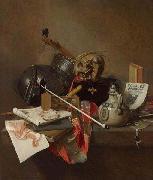 |
Jan Jansz. Treck 
|
|
(1606, Amsterdam, 25 September 1652 ) was a still-life painter during the Dutch Golden Age. Treck used economy in the number of his objects.
In 1623 Treck was trained for half a year by Jan den Uyl, who had married his sister Geertruid in 1619. His style also shows influence by Pieter Claesz and Willem Heda. In 1643 and 1644 Treck was trained by Abraham Jansz for 4 guilders a week, but forgot to pay for his apprenticeship. He also had to pay for a window that was made to get more light, while working.
His earliest known signed and dated work is from 1641, after the death of Den Uyl. A work has surfaced with both signatures, implying that Treck perhaps finished Den Uyl's paintings after his death. Treck also had helped his brother-in-law to sell his house (on Singel) in 1639. After the death of his friend Abraham, Treck bought his equipment, paint and easel. In 1640 he supplied the art dealer Hendrick Uylenburgh with money.
After Treck's death his brother, sister and his niece and nephews inherited a small house in an alley from Singel to Spuistraat, furniture, clothes, stocks, coins, jewelry, prints and paintings. In 1661 Simon Luttichuys was asked to repaint a vanitas done by Treck.
Treck influenced Pieter van Anraedt and Willem Kalf.
|
|
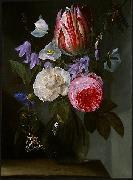 |
Jan Philip van Thielen 
|
|
(Mechelen, 1618 - Mechelin, 1667) was a Flemish Baroque painter who specialized in flowers.
Van Thielen was the son of a minor nobleman and eventually assumed the title of Lord of Couwenberch. In 1631 or 1632 he began studying at the age of thirteen with his future brother-in-law, the history painter Theodoor Rombouts (1597-1637), and in 1641 he commenced his studies with the flower painter Daniel Seghers (1590-1661). According to Houbraken (who mistakenly wrote his birth year as 1681 instead of 1618), his reputation during his lifetime was such that he received patronage from the Spanish crown,
|
|
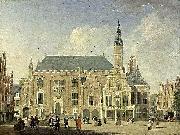 |
Jan ten Compe 
|
|
painted view of the Town Hall in 18th century
|
|
|
|
|
|
|
|
|
| Wholesale China Oil Painting Wholesale Oil Painting China Xiamen Portrait Reproduction on canvas Chinese Oil Painting Wholesale USA Oil Painting |
|
|
|
|